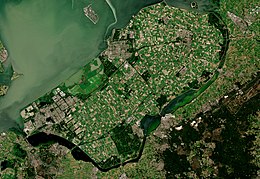This article has multiple issues. Please help
improve it or discuss these issues on the
talk page. (
Learn how and when to remove these template messages)
|
 The Flevopolder | |
|
| |
| Geography | |
|---|---|
| Location | Flevoland |
| Coordinates | 52°30′N 5°28′E / 52.500°N 5.467°E |
| Area | 970 km2 (370 sq mi) |
| Administration | |
| Largest settlement | Almere [1] (pop. 202,764) |
| Demographics | |
| Population | 317,000 |

The Flevopolder is an island polder forming the bulk of Flevoland, a province of the Netherlands. Created by land reclamation, its northeastern part was drained in 1955 and the remainder—the southwest—in 1968.
Unlike other major polders, it is surrounded by lakes and below-sea-level channels. By some definitions, it is the world's largest artificial island. Levees, dikes, and pumping were used to drain the land. The polder's name references the ancient Lake Flevo. The Flevopolder, along with the Noordoostpolder, forms the Flevoland province, which is located near Amsterdam in the southwest and Kampen, Overijssel in the northeast.
Boundaries
Unlike other major polders, such as Noordoostpolder and Wieringermeer, the Flevopolder is surrounded by bordering lakes or below-sea-level channels. These are the IJsselmeer, the Veluwemeer, Ketelmeer, and Gooimeer. By some definitions, it is the largest artificial island in the world. [2] [3] [a]
History
Reclamation of its land
Levees and dikes were first built around the polder. However, unlike similar projects, the internal water was then drained by diesel and electric pumps.
Etymology
Its name refers to the ancient Lake Flevo.
Geography
The Flevopolder together with the Noordoostpolder forms the province of Flevoland, the most recent province to be added to the Netherlands. Its southwestern point is close to Amsterdam and its opposite end is close to Kampen, Overijssel. It has three highly dominant settlements in terms of distribution of population.
Footnotes
- ^ René-Levasseur Island in the Canadian province of Quebec is considerably larger than the Flevopolder. However, this island was a natural landform that became an island after the completion of the Daniel-Johnson dam in the late 1960s created Manicouagan Reservoir.
References
- ^ "Bevolkingsontwikkeling; regio per maand" [Population growth; regions per month]. CBS Statline (in Dutch). CBS. 1 January 2021. Retrieved 2 January 2022.
- ^ "How a Nazi Blockade Triggered a Food Revolution". Bloomberg News via YouTube. November 2, 2018. Archived from the original on 2021-12-21.
- ^ "Dutch Flevoland - The Largest Man-Made Island". www.tourism-review.com. 28 April 2014. Retrieved 22 November 2015.